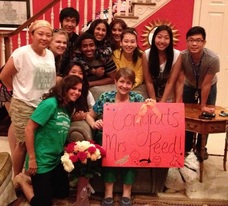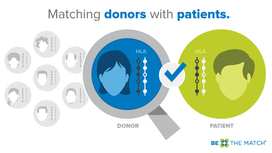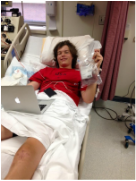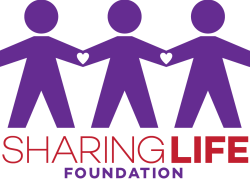Did You Know?
Blood Stem Cell Transplants Cure 70+ Blood Cancers & Chronic Diseases!
Each year, approximately 20,000 people in the U.S. are in need of a marrow/stem cell transplant due to a disease or condition that prevents the body from making enough healthy blood cells. We can't live without blood. Blood stem cell transplantation can replace the defective cells with healthy ones.
Hematapoietic (blood) Stem Cell Transplants can put more than 70 diseases and conditions into remission, including:
* blood cancers (e.g., leukemia, lymphoma, MPN, MDS);
* severe blood diseases (thalassemia, aplastic anemia, sickle cell anemia); and
* some immune-deficiency diseases (e.g., severe combined immunodeficiency syndrome, congenital neutropenia, and chronic granulomatous disease).
A transplant physician will determine whether a patient could benefit from a blood stem cell transplant. He or she considering many factors including the type and severity of the disease, past treatments, the age and overall health of the patient, and other available treatment options.
More children die of acute leukemia each year than any other form of cancer.
Of the 20,000 sick patients, more than 14,000 (70%) do not have a donor within their family. And 60% are not able to find a compatible donor.
Hematapoietic (blood) Stem Cell Transplants can put more than 70 diseases and conditions into remission, including:
* blood cancers (e.g., leukemia, lymphoma, MPN, MDS);
* severe blood diseases (thalassemia, aplastic anemia, sickle cell anemia); and
* some immune-deficiency diseases (e.g., severe combined immunodeficiency syndrome, congenital neutropenia, and chronic granulomatous disease).
A transplant physician will determine whether a patient could benefit from a blood stem cell transplant. He or she considering many factors including the type and severity of the disease, past treatments, the age and overall health of the patient, and other available treatment options.
More children die of acute leukemia each year than any other form of cancer.
Of the 20,000 sick patients, more than 14,000 (70%) do not have a donor within their family. And 60% are not able to find a compatible donor.
 Marina celebrating with family and friends the night her perfect match was found!
Marina celebrating with family and friends the night her perfect match was found!
What is a "Matching Donor"?
The ideal potential donor must be an exact match on 10 specific human leukocyte antigens (HLAs). A good match helps increase success and minimize graft vs. host disease (where the donor’s cells attack the patient’s cells). The patient and donor can have different blood types.
Can a family member donate?
Siblings have a 25% likelihood of being a full match for a patient. While siblings have the highest likelihood of being a match, over 70% of patients do not match with their siblings.
Finding a donor is difficult if the patient does not have a matching family member. The donor registry is not extensive enough to find a match for everyone who needs one.
Doesn't every patient find someone to donate for them?
Sadly, 60% of people who need a marrow/stem cell transplant do not have a matching donor.
A Black, Latino, Native American, or Asian person needing a marrow/stem cell transplant has less than 20% chance of finding a matching donor in the registry. A caucasian person has >80% chance of finding a life-saving unrelated donor match because most of the donors in the registry are caucasian. This is why more healthy young people of all race and ethnic backgrounds are needed to swab and join the registry. You never know when you or someone you love may need this gift of life.
The ideal potential donor must be an exact match on 10 specific human leukocyte antigens (HLAs). A good match helps increase success and minimize graft vs. host disease (where the donor’s cells attack the patient’s cells). The patient and donor can have different blood types.
Can a family member donate?
Siblings have a 25% likelihood of being a full match for a patient. While siblings have the highest likelihood of being a match, over 70% of patients do not match with their siblings.
Finding a donor is difficult if the patient does not have a matching family member. The donor registry is not extensive enough to find a match for everyone who needs one.
Doesn't every patient find someone to donate for them?
Sadly, 60% of people who need a marrow/stem cell transplant do not have a matching donor.
A Black, Latino, Native American, or Asian person needing a marrow/stem cell transplant has less than 20% chance of finding a matching donor in the registry. A caucasian person has >80% chance of finding a life-saving unrelated donor match because most of the donors in the registry are caucasian. This is why more healthy young people of all race and ethnic backgrounds are needed to swab and join the registry. You never know when you or someone you love may need this gift of life.

Misconceptions about bone marrow donations make many people reluctant to register. Despite the fact that most transplants do not involve much more than the equivalent of a blood donation, more than 3,000 people die waiting for a bone marrow transplant each year.
Only 2% of the American public is on the National Marrow Donor Registry, so finding a match can be like trying to find a needle in a haystack – 1 in 20,000 to be exact.
Only 2% of the American public is on the National Marrow Donor Registry, so finding a match can be like trying to find a needle in a haystack – 1 in 20,000 to be exact.

Can I Become a Bone Marrow / Stem Cell Donor?
All Potential donors MUST have:
What is My Commitment?
Your tissue type will be listed anonymously on the registry with which you joined (e.g., Delete Blood Cancer or Be The Match Registry®) until your 61st birthday unless you asked to have it removed. You must be willing to consider donating to any patient who needs you. You must keep your contact information and health status updated in the registry's database at all times. If your health circumstances change which preclude you from donating (e.g., major medical illness), contact your registry and let them know.
Remember, if you are contacted, you are likely someone's last hope.
What Happens if I am Someone's Match?
If you are a match for a patient, you will be contacted by your registry. There are several steps: You will fill out a health questionnaire, and then have some blood drawn for further testing. The registry coordinates information with the patient's transplant doctor. If you are selected as the best match, you will undergo a series of health tests to ensure that you are healthy and it is safe for you to donate your marrow/stem cells. If so, you will donate in one of two ways, to be determined by the patient’s doctor.
If I'm a Match, How Do I Give my Stem Cells?
75% of donations are Peripheral Blood Stem Cell collection
Similar to donating plasma or platelets, the donor's blood is collected through a vein in one arm. The blood goes through a machine and the stem cells are separated out and the blood is returned to the patient in the other arm. You will receive a daily injection for four days of a protein called filgrastim to stimulate production of more blood stem cells and get them circulating in your system.
This is an outpatient procedure that takes about 4-8 hours on 1 or 2 consecutive days. While taking filgrastim, some donors experience flu-like symptoms, such as headaches, bone and muscle achiness and fatigue. Most side effects subside within 48 hours of donating.
25% of donations are collected by Bone Marrow aspiration
Marrow cells are collected from the backside of the donor's pelvic bone (not the spine) using a special syringe. The donor is given general anesthesia for the 1-2 hour procedure so no pain is experienced during the collection. Many donors experience some minor soreness or bruising around the collection site. Some donors compare it to the pain of a slip and fall on their tailbone.
This procedure is used more often for young patients.
What's the deal with these Different Registries? Do I need to register with all of them?
In a country as large and diverse as the United States, and only 10 million adults registered to donate marrow/stem cells, there are several organizations working to educate people and encourage them to get involved.
The good news: if you've registered with one organization, your (privacy-protected) HLA information is available through national and international registry coordination.
Marrow Donor Registries
Marrow donor registries must meet stringent requirements to be accredited by the World Marrow Donor Association (WMDA). The Bone Marrow Donors Worldwide (BMDW) is the worldwide coordinator of donor HLA phenotype information and is responsible for the coordination of the distribution of donor cells to patients around the world. Participants are 75 stem cell donor registries from 53 countries, and 53 cord blood registries from 36 countries.
Be the Match® National Recruitment & Registry
Be the Match is the designated National Marrow Donor Program for the United States. All the US registries tie into this one.
They also provide education for prospective donors as well as ongoing information and support to patients and their families going through marrow/stem cell transplantation. Be the Match ® registers healthy people ages 18-44 years of age, as doctors prefer to use the stem cells of younger donors.
Delete Blood Cancer DKMS National Recruitment & Registry
Delete Blood Cancer has a US registry of over 500,000 potential donors. It is an associate donor registry to the National Marrow Donor Program. They have branches in the U.S., Germany, the U.K., Poland and Spain. Globally, they have registered over 5.9 million donors and provided more than 53,000 patients with second chances at life.
Gift of Life Bone Marrow Foundation National Recruitment & Registry
Gift of Life is an associate donor registry of the National Marrow Donor Program (NMDP) and an accredited registry by the World Marrow Donor Association (WMDA). Founded by a transplant recipient, Gift of Life has held more than 7,000 swab drives and registered more than 250,000 donors. It is based in Florida and supports drive nationally.
Donor Recruitment Organizations
These nonprofit organizations run swab drives across the country. They partner with national registries (see above) and use their community networks to spread the word and register more marrow donors.
Asian American Donor Program
The Asian American Donor Program (AADP) specializes in conducting outreach and donor registration drives in and with diverse communities. AADP is an official recruitment center of the Be The Match registry. It is based in Alameda, California.
Genny's Hope Foundation
Genny's Hope was founded by the mother of a transplant recipient with a bold goal: to register 1,000,000 people with the marrow donor registry. Based in Colorado, volunteers from Genny's Hope help people wanting to hold swab drives in their communities.
Love Hope Strength Foundation
Since 2010, Love Hope Strength has been hosting "Get on the List" donor drives at concerts and festivals across the globe. So far, they have added over 122,000 music fans to the registry and find over 2,200 potentially lifesaving matches giving hope to those with Leukemia and other diseases who would otherwise be denied the chance of life. Throughout, they have been raising awareness about the less painful techniques that enable donors to give cells in an outpatient setting.
I Can't Join the Registry for Health Reasons. What Can I Do?
There is A LOT you can do to help!
All Potential donors MUST have:
- 18 - 55 years of age (most selected donors are ages 18-35)
- General good health
- Weight >110 lbs & Body Mass Index <40
- No personal history of cancer or autoimmune disease
- No history of blood clotting or bleeding disorder
- No HIV+ or AIDS
- No Hepatitis B or C
- No Diabetes requiring insulin
- No heart surgery or heart disease
- No history of stroke
What is My Commitment?
Your tissue type will be listed anonymously on the registry with which you joined (e.g., Delete Blood Cancer or Be The Match Registry®) until your 61st birthday unless you asked to have it removed. You must be willing to consider donating to any patient who needs you. You must keep your contact information and health status updated in the registry's database at all times. If your health circumstances change which preclude you from donating (e.g., major medical illness), contact your registry and let them know.
Remember, if you are contacted, you are likely someone's last hope.
What Happens if I am Someone's Match?
If you are a match for a patient, you will be contacted by your registry. There are several steps: You will fill out a health questionnaire, and then have some blood drawn for further testing. The registry coordinates information with the patient's transplant doctor. If you are selected as the best match, you will undergo a series of health tests to ensure that you are healthy and it is safe for you to donate your marrow/stem cells. If so, you will donate in one of two ways, to be determined by the patient’s doctor.
If I'm a Match, How Do I Give my Stem Cells?
75% of donations are Peripheral Blood Stem Cell collection
Similar to donating plasma or platelets, the donor's blood is collected through a vein in one arm. The blood goes through a machine and the stem cells are separated out and the blood is returned to the patient in the other arm. You will receive a daily injection for four days of a protein called filgrastim to stimulate production of more blood stem cells and get them circulating in your system.
This is an outpatient procedure that takes about 4-8 hours on 1 or 2 consecutive days. While taking filgrastim, some donors experience flu-like symptoms, such as headaches, bone and muscle achiness and fatigue. Most side effects subside within 48 hours of donating.
25% of donations are collected by Bone Marrow aspiration
Marrow cells are collected from the backside of the donor's pelvic bone (not the spine) using a special syringe. The donor is given general anesthesia for the 1-2 hour procedure so no pain is experienced during the collection. Many donors experience some minor soreness or bruising around the collection site. Some donors compare it to the pain of a slip and fall on their tailbone.
This procedure is used more often for young patients.
What's the deal with these Different Registries? Do I need to register with all of them?
In a country as large and diverse as the United States, and only 10 million adults registered to donate marrow/stem cells, there are several organizations working to educate people and encourage them to get involved.
The good news: if you've registered with one organization, your (privacy-protected) HLA information is available through national and international registry coordination.
Marrow Donor Registries
Marrow donor registries must meet stringent requirements to be accredited by the World Marrow Donor Association (WMDA). The Bone Marrow Donors Worldwide (BMDW) is the worldwide coordinator of donor HLA phenotype information and is responsible for the coordination of the distribution of donor cells to patients around the world. Participants are 75 stem cell donor registries from 53 countries, and 53 cord blood registries from 36 countries.
Be the Match® National Recruitment & Registry
Be the Match is the designated National Marrow Donor Program for the United States. All the US registries tie into this one.
They also provide education for prospective donors as well as ongoing information and support to patients and their families going through marrow/stem cell transplantation. Be the Match ® registers healthy people ages 18-44 years of age, as doctors prefer to use the stem cells of younger donors.
Delete Blood Cancer DKMS National Recruitment & Registry
Delete Blood Cancer has a US registry of over 500,000 potential donors. It is an associate donor registry to the National Marrow Donor Program. They have branches in the U.S., Germany, the U.K., Poland and Spain. Globally, they have registered over 5.9 million donors and provided more than 53,000 patients with second chances at life.
Gift of Life Bone Marrow Foundation National Recruitment & Registry
Gift of Life is an associate donor registry of the National Marrow Donor Program (NMDP) and an accredited registry by the World Marrow Donor Association (WMDA). Founded by a transplant recipient, Gift of Life has held more than 7,000 swab drives and registered more than 250,000 donors. It is based in Florida and supports drive nationally.
Donor Recruitment Organizations
These nonprofit organizations run swab drives across the country. They partner with national registries (see above) and use their community networks to spread the word and register more marrow donors.
Asian American Donor Program
The Asian American Donor Program (AADP) specializes in conducting outreach and donor registration drives in and with diverse communities. AADP is an official recruitment center of the Be The Match registry. It is based in Alameda, California.
Genny's Hope Foundation
Genny's Hope was founded by the mother of a transplant recipient with a bold goal: to register 1,000,000 people with the marrow donor registry. Based in Colorado, volunteers from Genny's Hope help people wanting to hold swab drives in their communities.
Love Hope Strength Foundation
Since 2010, Love Hope Strength has been hosting "Get on the List" donor drives at concerts and festivals across the globe. So far, they have added over 122,000 music fans to the registry and find over 2,200 potentially lifesaving matches giving hope to those with Leukemia and other diseases who would otherwise be denied the chance of life. Throughout, they have been raising awareness about the less painful techniques that enable donors to give cells in an outpatient setting.
I Can't Join the Registry for Health Reasons. What Can I Do?
There is A LOT you can do to help!
- Get the Facts and Spread the Word. Ask 3 people if they know about stem cell donation; then tell them about it and us.
- Volunteer to work at a donor registry drive (aka Swab Drive) near you. Talk it up!
- Organize a donor registry drive in your community, or at your office or school, or school, and register new donors for Delete Blood Cancer.
- Encourage family, friends and others to register online at getswabbed.org
By profiling one woman’s story with blood cancer we hope to both raise awareness about the need for donor registration and let other cancer patients know they are not alone in their struggle.
Image borrowed from Be the Match

